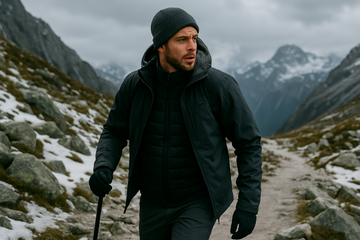High-altitude environments are no joke. Whether you're trekking through the Rockies, camping under the stars in Patagonia, or skiing in the Alps, temperatures can drop fast — especially after sunset. Factor in wind chill and unpredictable weather, and suddenly your regular puffer jacket doesn’t cut it.
The big question: Can a heated vest truly hold up in these extreme settings? We put it to the test.
Field Testing Conditions: Where and How We Used It
To mimic the real-world challenges our customers face, we tested our heated vest in some of the most demanding conditions, including:
- Mountain hikes with elevation gains (2000–4000m)
- Winter overlanding trips, with days spent in snow and nights in tents
- Backcountry ski outings, where core warmth without bulk is critical
- Remote expeditions, where packing light is essential and power sources are limited

These are not promotional stunts — they're situations many outdoor travelers, photographers, campers, and cold-weather commuters actually encounter.
Key Features That Matter in Harsh Conditions
When you’re dealing with harsh altitude or cold-weather conditions, not all heated vests are created equal. Here’s what stood out in our tests:
- Strategic Heating Zones: Carbon fiber heating elements across the back and abdomen
- Adjustable Heating Levels: Three temperature settings for changing conditions
- Long-Lasting Battery Life: Up to 8–10 hours of heat with a 10,000mAh battery
- Lightweight Design: Fits easily under an outer shell without bulk
- Water-Resistant & Machine-Washable: Built for real-world use
How It Actually Performs in the Wild
1. Warmth That Works
The vest delivers noticeable heat within seconds. On a pre-dawn hike in subzero temps, it kept testers warm without the need for multiple thick layers. In situations with strong wind, wearing it under a windproof shell significantly boosted effectiveness.
2. Mobility & Layering
Unlike traditional thermal gear, the slim fit didn’t interfere with arm or torso movement — ideal for skiing, climbing, or carrying gear. Many testers used it as a mid-layer between a base and shell, and said it didn’t bunch, overheat, or weigh them down.

3. Battery Reliability at Altitude
Low temperatures typically drain battery life, but with a fully charged 10,000mAh pack, even our testers in Iceland and the Canadian Rockies reported 6–9 hours of real-time heat. Carrying a spare battery added backup for multiday treks.
4. Packability & Convenience
The vest folds compactly and weighs less than most insulated jackets. No fluff, no waste of space. This made it easy to carry on flights and convenient for thru-hiking or bikepacking where every ounce matters.

Altitude-Specific Advice
- Use the lowest heat setting during activity to conserve battery
- Keep your backup battery warm (in an inside pocket) to prevent power loss
- Air dry the vest fully before packing, especially in humid or snowy climates
- Check airline guidelines when flying with power banks — most allow up to 100Wh in carry-on bags
Final Verdict: Is It Worth Bringing?
Yes — if you care about comfort, mobility, and carrying less without sacrificing warmth.
Our heated vest isn’t just for extreme adventurers. It's ideal for:
- Cold-sensitive travelers
- Ultralight backpackers
- Outdoor photographers or film crews on location
- Anyone who hates layering five shirts just to survive a windy trailhead
Explore Heated Gear That’s Built for the Wild
Ready to take on the cold in comfort?
Discover how our latest heated vests are built to perform — whether you’re heading into the mountains or just trying to stay warm on your next winter commute. Designed for real conditions. Trusted by real adventurers.
Explore the full collection now and gear up for whatever’s next.






